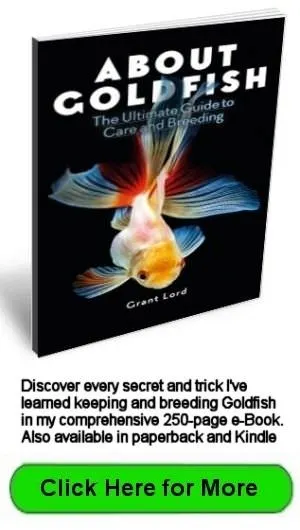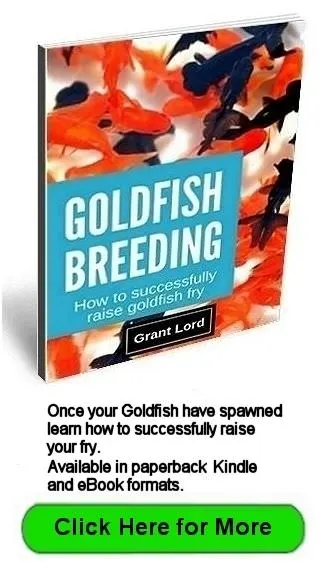- Home
- How Long do Goldfish Live?
How Long Do Goldfish Live?
Under ideal conditions, Goldfish are a long-living species, living much longer than the family dog or cat.
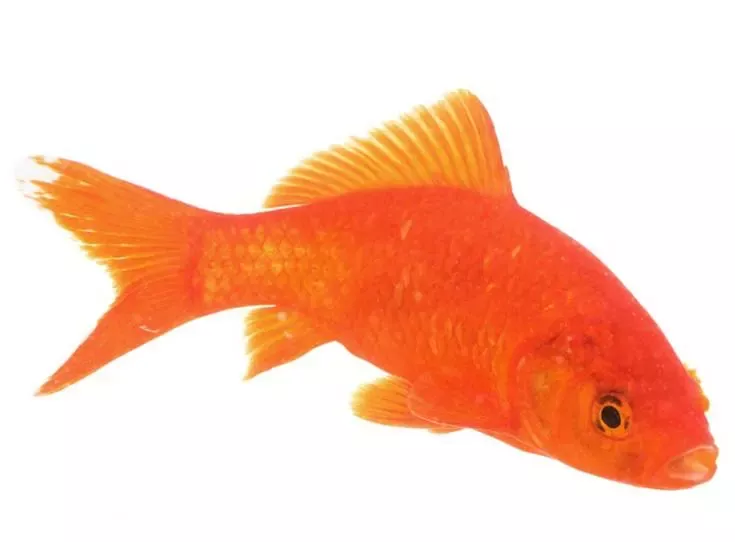 A Large Common Goldfish should live for 20+ years.
A Large Common Goldfish should live for 20+ years.Introduction
How long do Goldfish live?
This is a frequently asked question because some Goldfish keepers manage to keep their Goldfish for years, sometimes decades, yet others only manage to keep them for a few months.
It is important to realize that Goldfish are a long-living species, and the care they are given dictates how long they will live. They are an easy fish species to keep, and if their basic needs are provided for, they will reward you with a long and disease-free life.
Last Updated: 11-12-2024 by Grant Lord.
Lifespan of Goldfish
Most Goldfish only live a fraction of their potential lifespan, living on average only a few months.
Ten years should be considered a minimum for a well cared for Goldfish. 20+ years is not uncommon for pond fish, and there are records of Goldfish living for over 40 years.
Common Misconceptions
A common misconception is that Goldfish are small fish with a lifespan similar to a small to medium sized tropical fish, which is 2 to 4 years at best. This is a reasonable assumption because, depending on your own personal experience, you may have had Goldfish live for only a few months or years.
Guppies are breeding at 6 weeks old. Goldfish only start to show what sex they are at around 6 months at the earliest and wouldn't breed until the following spring.
What all this indicates is that Goldfish will live a lot longer than the average tropical fish.
Common Goldfish kept in ideal conditions can grow to 12 inches (300mm) in body length and possibly even larger in the wild. This is a large aquarium fish by any standards, and generally, the larger the animal, the longer it lives. However, size isn't the only factor determining how long a Goldfish will live.
Factors Affecting Goldfish Lifespan
Many factors determine how long any living creature will live, and Goldfish are no different.
Here are the most important ones:
Water Quality
Water quality is the most frequent cause of premature death in Goldfish.
Goldfish will tolerate a wide variety of water conditions, but this does not include polluted water, which has ammonia or nitrites present. Both damage skin and gills, and nitrites stop the uptake of oxygen. If they don't kill the fish directly, they will cause stress which, shortening its lifespan.
Although nitrates are far less toxic than nitrites, they still harm Goldfish if they rise too high. Where once it was believed nitrates as high as 200 ppm (parts per million) were safe, now anything over 40 ppm is considered getting into the dangerous level.
High nitrates constrict the blood vessels, which can lead to buoyancy problems in fancy varieties as the blood vessels surrounding the swim bladders have a reduced ability to supply oxygen.
I have found that young fry (babies) will start showing buoyancy problems when nitrates rise above 5 ppm.
Ideal water conditions for Goldfish are:
- Water that has a pH of 7.0-7.4
- Nitrates below 20 ppm (parts per million)
- Zero ammonia and nitrites
- GH (General Hardness) between 130-200ppm (dGH 7-11)
- KH (Carbonate Hardness) between 89-142ppm (dKH 5-8)
- A temperature around 20-23oC (68 - 74oF).
Diet
The natural foods of Goldfish are aquatic plants, invertebrates, insect larvae, daphnia, and any other animals they can fit into their mouths.
All these foods are soft, moist, and easily ingested. Most commercially available foods for Goldfish are dry prepared flakes or pellets.
The rear air or swim bladder of a Goldfish has an opening into the digestive tract. The Goldfish controls its buoyancy by inflating or deflating its swim bladder by gulping or expelling air through its mouth.
If poor quality or stale food is eaten, it can cause two problems, constipation or gas build-up in the intestine.
Both these conditions stop the Goldfish's ability to control its buoyancy, which is why after being fed dry prepared food, Goldfish often develop buoyancy problems until the food passes through the intestine.
This isn't such a problem with slim-bodied varieties such as Comets. However, as deep-bodied fancy varieties get older, they become less tolerant of dry prepared foods and a lack of green matter in their diet. If they don't get a change of diet, this condition often turns permanent, and due to other complications, the fish usually die soon after.
I have Black Moor strain that gets
buoyancy issues
as they age, especially if fed flake food or pellets. Since
changing to gel foods several years ago, I haven't had a single fish die from complications from a swim bladder disorder. Occasionally, I still get a fish with a buoyancy problem, but it is usually temporary, and I know it's not caused by diet.
Water Temperature
Those who keep or have kept small tropical fish will have found that most lifespans are relatively short, 5 years being exceptional. One of the reasons for this is the high water temperatures they live in all year round, and with that comes a high metabolic rate. Water temperature plays a large part in the lifespan of fish. The colder the water, the longer they live.
Goldfish are warm water fish, not tropical. They can live in water just above freezing and will survive at temperatures as high as 38oC (100oF) but prefer temperatures around the low 20s Celsius (68-74oF).
Most Goldfish live in unheated aquariums and ponds, so when winter arrives with its lower temperatures, Goldfish go into a period of low activity or hibernation if temperatures are low enough.
Goldfish owners who keep their fish heated at higher temperatures all year round are dramatically shortening the lives of their fish!
Having said that, I don't let my fancy varieties stay in water below 10oC (50oF) for any length of time, and my water never freezes.
Space
Size seems to have a bearing on lifespan. A Goldfish needs a lot of space to reach its maximum size. This is why the largest specimens seen are usually fish caught in natural waterways.
Fish kept in aquariums and bowls rarely have pristine water conditions. Goldfish release growth-inhibiting pheromones, and unless their water is changed very frequently, their growth is constantly being affected by these pheromones. Aquarium-raised fish seldom reach the size of pond-raised fish.
Generally, fish kept in ponds live the longest, and in bowls the shortest. Aquarium fish moved to ponds over the warmer months seem to get a health boost. Exposure to sunlight, natural foods, and a growth spurt are probably factors.
I keep my adult fish outside in ponds year-round, including Celestials and Water Bubble Eyes, both highly developed fancy varieties.
Early Life Care
Fry (baby goldfish) are susceptible to parasites, especially flukes. If they get infested, they either die or their growth rate is severely slowed.
The first few weeks are when the most growth takes place. If fry are stunted because of parasites or poor water conditions, they never recover from this. They always remain undersized compared to similarly aged fish and don't seem so robust.
I take meticulous care to ensure eggs and fry are not exposed to parasites the adults may be carrying by flushing them with fresh, clean water and transferring them to a hatching tank. I also treat the adults for parasites at the start of the breeding season, even though I know they most likely aren't carrying any.
Health
The health of a Goldfish is primarily governed by water quality, but all the previously mentioned factors have a bearing on overall health.
If a fish is carrying parasites such as lice or anchor worm, which occur irrespective of water quality, it will be weakened by the parasites and is susceptible to secondary diseases such as bacterial infection and fungus, both fatal if left untreated.
Mixing Incompatible Varieties
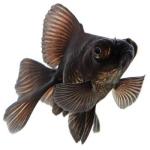 Black Moor
Black MoorThis is one of the most common mistakes novice Goldfish keepers make.
Often, a highly developed variety such as a Water Bubble Eye, Celestial, or, most commonly, a Black Moor is kept in a community tank with normal-eyed varieties or, worse, single-tailed varieties.
They expect a myopic (short-sighted), slow-swimming fish to compete with normal-eyed, fast, and agile single-tailed varieties.
What generally happens is over time, the highly developed variety slowly starves until finally, it succumbs to disease. This helps perpetuate the myth that fancy varieties don't live very long.
Competition for food is so fierce that when I
temporarily
keep Celestials and Black Moor together, I notice the Celestials soon start to lose condition.
Variety and Genetics
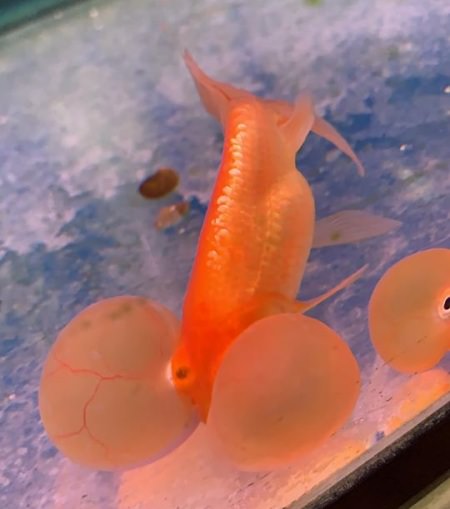 Bubble Eye
Bubble EyeThere are over 100 different varieties of Goldfish. The more developed varieties, such as Celestials, Water Bubble Eyes, and Moors, have the most mutated genes, which is believed to weaken them.
Having said that, I have seen pictures of a 40+ year-old Oranda.
Inbreeding has the same weakening effect, which is why some top breeders cross their fancy varieties back to Common Goldfish after a certain number of successive years of line breeding to re-strengthen the gene pool.
The rate at which an animal ages is built into its genetic blueprint at birth. However, most Goldfish never live long enough for it to be considered a cause of death. Most Goldfish only live at best, around 20% of their potential lifespan.
Asian-Sourced Goldfish
There is some evidence that Asian-sourced fish are not long-lived fish, with 5 years being a maximum age.
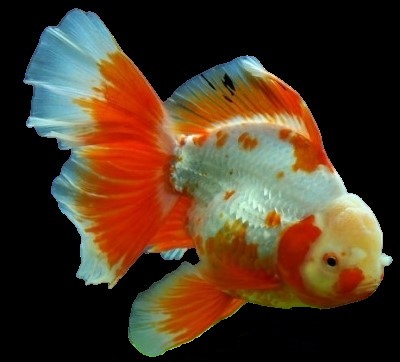 Asian-sourced fancy Goldfish
Asian-sourced fancy GoldfishThese fish are kept in very warm water to speed up growth and are fed continuously on high carbohydrate foods to promote deep bodies. Some of these fish attain almost full size within 12 months.
Large fish are popular and sell at high prices.
Breeders find these forced-grown fish hard to breed with spawn sizes small. Fish that experience winter temperatures after the growing season, as happens in the wild, appear to be more robust and are bred more successfully.
How to Increase a Goldfish Lifespan
A lot of the factors that affect how long a Goldfish will live are pre-determined before you even see the fish in your favorite local fish store, but the most important ones you can influence are:
Living Environment
Goldfish kept in bowls have the shortest lifespans. Those kept in ponds have the longest. Always maintain high water quality through frequent water changes. Use a water test kit to measure your aquarium or pond water pH, nitrate, and ammonia levels. As soon as one of these moves outside the desired range, make a water change.
Unless you change the water in a bowl daily, it is very hard to keep the water quality high.
Aquariums make it much easier to manage water quality using filters, but water changes still aren't done often enough.
Ponds allow Goldfish to grow large and receive natural sunlight. If Goldfish are put into a pond over the warmer months, it boosts their coloration and health.
Diet
Feed live foods and vegetable matter as often as possible, and when these aren't available, high-quality foods that copy the natural foods of Goldfish, namely soft, moist, and easily digestible. Gel foods fit these requirements exactly.
Quarantining New Arrivals
Introducing a few fish into your fish community without first quarantining it is like playing a lottery. You may be fortunate and have no problems whatsoever, or you will spend the next few months medicating all your fish.
Quarantining should include treating the new fish for parasites, whether they display symptoms or not. Healthy fish can carry a few parasites without ever succumbing to them, and your fish may not have had much exposure to the ones the new fish could carry.
Likewise, you need to be sure your existing fish aren't carrying parasites to which the new fish may not have been exposed. Often, a healthy, disease-free post-quarantined fish will develop disease symptoms a few days after being put into a community tank.
Conclusion
So, the question should not be, how long do Goldfish live? But how long should Goldfish live?
Goldfish are revered in China and Japan and have been kept there for centuries, so they should know how to look after them. In these countries, there have been recorded instances where Goldfish have attained the ripe old age of 40+ years.
This isn't common, but 20-30 years old is.
For fish kept in a bowl, 3 years would be an exceptional lifespan.
In an aquarium, with filtration, 10 years should be expected, longer if they spend some time outside in a pond each year.
In a pond with filtration, 15+ years isn't uncommon.
Goldfish that have lived long lives in aquariums seem to have these characteristics:
- They were Commons, Comets, or Shubunkins, all single-tailed varieties
- Their aquariums were unheated
- High water quality was always maintained
- They were fed sparingly.
As you have discovered, providing the basic requirements to ensure your Goldfish live long and healthy lives is easy.
Top of How long do Goldfish Live page
